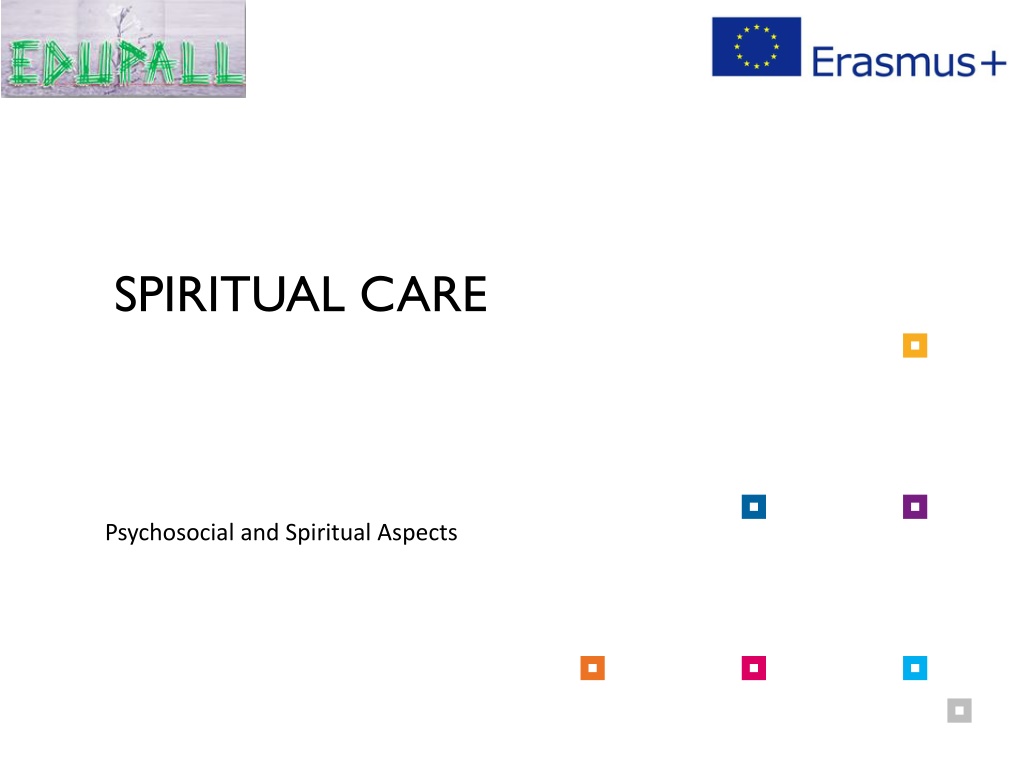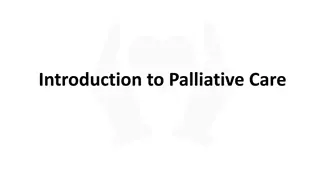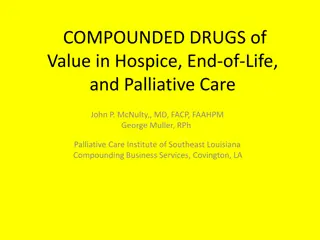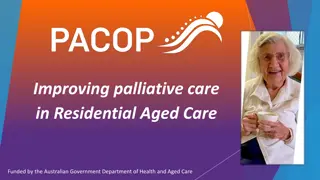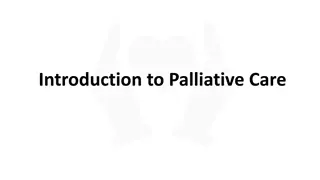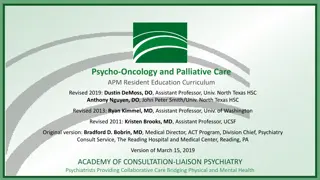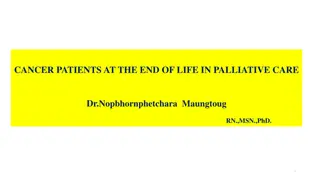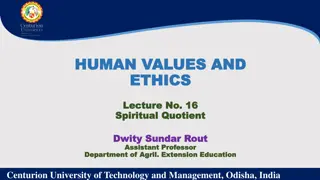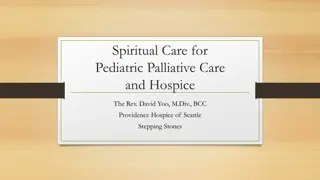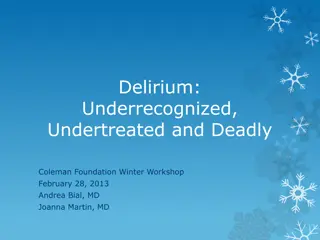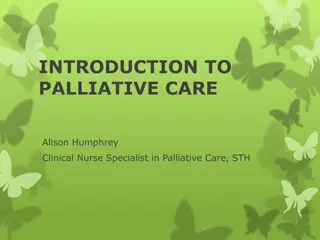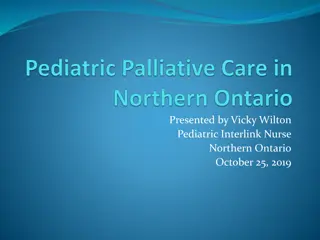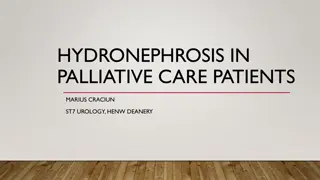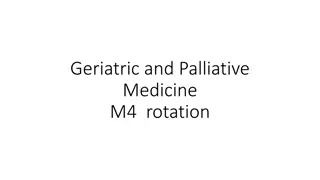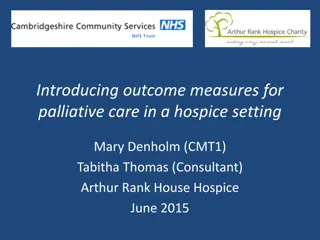Spiritual Care in Palliative Settings
Exploring the essence of spiritual care in palliative care, this content delves into defining spirituality, its impact on individuals with life-limiting conditions, and the role of healthcare professionals in providing holistic support. It highlights the significance of addressing spiritual, psychosocial, and emotional needs for comprehensive end-of-life care.
Download Presentation

Please find below an Image/Link to download the presentation.
The content on the website is provided AS IS for your information and personal use only. It may not be sold, licensed, or shared on other websites without obtaining consent from the author.If you encounter any issues during the download, it is possible that the publisher has removed the file from their server.
You are allowed to download the files provided on this website for personal or commercial use, subject to the condition that they are used lawfully. All files are the property of their respective owners.
The content on the website is provided AS IS for your information and personal use only. It may not be sold, licensed, or shared on other websites without obtaining consent from the author.
E N D
Presentation Transcript
SPIRITUAL CARE Psychosocial and Spiritual Aspects
Objectives C A1 Defines spiritual care and explain the relationship / differences between spirituality and religion C A2 Describes how spiritual issues affect people with life-limiting conditions and their families throughout the continuum of care C A3 Explains role of the Doctor (and wider MDT) regarding spiritual care, expertise and tasks of multidisciplinary team members in spiritual care. C B4 Shows trustworthiness in seeking additional spiritual support
Working definition Spirituality is the dynamic dimension of human life that relates to the way persons (individual and community) experience, express and/or seek meaning, purpose and transcendence, and the way they connect to the moment, to self to others, to nature, to the significant and/or the sacred. Best et Al. (2019) or EAPC Spiritual Care taskforce
Remember Total Pain Physical Patient & family Spiritual Psychological Social
Factors Considered Important at the End of Life (Steinhauser, KE, et al. JAMA 284: 2476-2482, 2000) Random national survey, March-August, 1999. Importance of 44 attributes of quality at EOL. Patients, bereaved family members, physicians, nurses, social workers, chaplains, and hospice volunteers were surveyed. 26 items rated as important across all groups including pain and symptom management, preparation for death, achieving a sense of completion, decisions about treatment preferences, and being treated as a whole person .
Factors at the End of Life... (Steinhauser, KE, et al. JAMA 284:2476-2482, 2000) Issues important to patients but not so important to physicians (p<0.001): 1) Be mentally aware. 2) Be at peace with God. 3) Not be a burden to family. 4) Be able to help others. 5) Pray 6) Have funeral arrangements planned. 7) Not be a burden to society. 8) Feel one s life is complete. More than half of the components identified are spiritual issues
Spiritual Care it is important to view spiritual care not as a compartmentalized feature of treatment but as an attitude that infuses the overall approach to whole- person care regardless of one s defined role in the care of a dying person. (Kaut, KP. Am Behav Scientist 46: 220-234, 2002)
WHAT Types of Interventions in Spiritual Care Psychotherapy Pastoral (chaplains) Religious Complementary Medical Care giver
Psychotherapy Dignity Therapy An Extension of Patient Biography Brief individualized psychotherapeutic intervention for those experiencing psychosocial and existential distress Goal of the intervention to encourage dying persons to discuss the most important issues in their lives by creating a generativity document a legacy by which they can share their experience and wisdom to the next generation 30-60 min taped interview (usually one) at bedside or in patient s home which is then reshaped (edited) into a narrative Narrative read to the patient in another session and patient allowed to edit it Helpful to bereaved persons in their grief Chochinov, HM, et al. J Clin Oncol 2005; 23:5520-5525 & McClement, S, et al. J Palliat Med. 2007; 10(5): 1076-1082
Pastoral Chaplain s Role in Spiritual Care Understand and clarify the spiritual meaning of all that is experienced by those involved within palliative care in the context of the chaplain s own relationship and understanding of God Discern spiritual needs of dying patients (and providers) Offer a ministry of word and sacrament (if appropriate) or pastoral counseling to patients, family caregivers, and to the organization (providers) Most critically, be present alongside those facing death or grief, transcending traditional religious boundaries Adapted from Speck, P. Oxford Textbook of Palliative Medicine, p.812, 1998
Religious Religion and Spiritual Care Spirituality is often grounded in a specific religious faith. Religion is a source of meaning and framework in which to understand the great existential questions of suffering and death. Religious rituals actualize belief/doctrine and provide tangible comfort and meaning. Chaplains and providers often are intermediaries in assisting patients find appropriate religious support. Ask about potential need for specific religious support earlier rather than later.
Religion in palliative care In end-of-life care, religion and religious tradition serves two primary functions: The provision of a set of belief about life events The establishment of an ethical foundation for a clinical decision-making
Judaism Christianity Islam Life is viewed as a time of preparation for hereafter Death is viewed as the beginning of a different form of life Assurance of spiritual security is vitally important to Christian patients facing death A good death can be achieved when the dying patient is relieved from both physical pain and emotional pain Life is a gift from God and is significant when it follows God s will. After death the soul still lives and it will be rewarded according to good or bad facts during life- time
Hindusim Buddhism Life is one of an infinite series If we die well with a peaceful mind, it will beneficially influence our next life Beliefs and practices vary considerably Most Hindus require time for meditation and prayer when small idols or pictures of goods may be kept under the pillow of the patient
Complementary Therapies Music therapy can provide a comforting and calming presence. (Knowing the patient s musical history is important) Touch (e.g., massage) Art Poetry Animal companions (i.e., pet therapy) *Common to all of these approaches is an effort to reduce the isolation of the dying person while at the same time reawakening the dying person s connection to the living. Cultural values will influence use of these kinds of therapies.
Medical Control pain Good symptom management Chaotic social circumstances will influence spiritual struggle No man can come to terms with his God when every waking moment is taken up with pain or vomiting. Oxford Textbook of Palliative Medicine, 2nd Edition, p. 6, 1998
Caregiver Basic - Express empathic concern - Be respectful of the patient s ultimate concerns - Be present for them, affirming their value - Listen to what they have to say about life and its meaning Complex - Refer to chaplain or patient s own clergy Sulmasy, DP. JAMA 2006; 296:1385-1392
HOW Measuring Spiritual Distress Research/Clinical Instruments Understanding the patient s spiritual framework and values Screening or triage for spiritual problems By Taking spiritual history Assessing/screening for spiritual needs
Measuring Spiritual Distress Spiritual History The Ars Moriendi ("Art of Dying") or Diamond-model is inspired by a medieval tradition which creates a common framework for communication and reflection on spirituality in palliative care within a secular and/or multi-faith society. FICA is a spiritual history-taking tool which was developed to help health care professionals address spiritual issues with patients in all settings. FICA serves as a guide for conversations in the clinical setting rather than a checklist, and is especially effective for patients who follow an organized religion. The SPIRITual History is a guide to identifying important components of the spiritual history for a broad range of patients. HOPE is a spiritual history-taking tool developed in a general practice context. FAITH is a spiritual history-taking tool which was developed for physicians and medical students. Q2-SAM is model developed to ensure person-centred care in nursing. It is based on two questions: What s most important to you now? How can we help?
Measuring Spiritual Distress Research/Clinical Instruments Spiritual Needs Assessment for Patients (SNAP) 23 items in three different domains: psychosocial (5), spiritual (13), and religious (5) Sharma, RK. et. al. J Pain Symptom Manage 44: 44-51, 2012 Functional Assessment of Chronic Illness Therapy Spiritual Well-Being Scale (FACIT-Sp): a 12 item instrument for measuring wellbeing in chronically ill patients Two subscales measure 1) a sense of meaning and peace; and 2) the role of faith in illness. Expanded version (FACIT-Sp-Ex) has an additional 11 questions that address other issues such as love, relationships with God and neighbor, gratitude, forgiveness, compassion for others, ability to appreciate beauty, and hope. http://www.facit.org/facitorg/questionnaires
Measuring Spiritual Distress Research/Clinical Instruments Brief RCOPE 14 item (7 positive and 7 negative) measure of religious coping with major life stressors (e.g., crisis, trauma, and transition) http://afterdeployment.t2.health.mil/sites/default/files/pdfs/assessment-tools/spirituality- assessment.pdf Distress Thermometer an attempt to measure patient s global distress with the visual prompt of a thermometer with a 0-10 scale (0=lowest and 10= highest distress) http://www.nccn.org/patients/resources/life_with_cancer/pdf/nccn_distress_thermometer.p df and http://www.nwlcn.nhs.uk/Downloads/Specialist-and-palliative- care/The%20Distress%20Thermometer%20leaflet%20draft.pdf Spiritual Distress Assessment Tool (SDAT) rare example of an instrument (5 items) designed to measure spiritual distress in elderly hospitalized patients on a geriatric rehabilitation unit. Monod, S. et al. BMC Geriatrics 2012 12:13.
Critique of Instruments for Measuring Spirituality Majority of instruments: Reflect an understanding of spirituality that essentially ignores religion, which is problematic in other cultures where spirituality is closely linked to religious faith See spirituality as a tool to be utilized in improving or maintaining health and quality of life a utilitarian view of spirituality Primary focus is on a spirituality that relates to the individual, namely the patient, with little reference, if any, to a larger communal aspect Sinclair, S, et al. J Pall Med, 9 (2): 464-479, 2006
Spiritual History F: Faith - Do you consider yourself religious or spiritual? Do you have a faith? I: Importance - Is it important in your life? C: Community - Are you part of a spiritual (or faith) community? A: Address - How can your healthcare providers address (and respect) these issues in your care? Validated instrument Borneman T., et al. J Pain Symptom Manage 40:163-173, 2010.
Spiritual History An integrated part of patient care (not an add-on like many research instruments) Spirituality is an ongoing issue - readdress it over time. In fact, one cannot address it effectively without forming a relationship with the patient as a person, which takes time and often many separate encounters. Refer to chaplains, spiritual directors, etc. when appropriate. However, the caregiver whom the suffering one trusts the most will likely be the one with whom deeper spiritual concerns will be shared. So all team members must be prepared to assist with spiritual care. Respect patients autonomy, do not impose your beliefs. Know thyself - You can t address a patient s spirituality until you address your own. Puchalski, C and Romer, AL J. Pall. Med. 3: 129-137, 2000
Spiritual History Are you at peace? Non-threatening and nonsectarian means of opening a conversation about emotional and spiritual concerns Strong correlation of peacefulness with measures of emotional and spiritual well being but also to a lesser extent with measures of physical, functional, and social well being Patient s response will guide further inquiry Steinhauser, KE, et al. Arch Intern Med 166:101-105, 2006.
Redefining Hope Patients need to know that they are dying. The role of being sick must transition to that of dying . Hospice can facilitate this transition by creating a new identity and point of reference for the dying patient. Hope can then be redefined in terms relevant to the new circumstances.
Redefining Hope Caregiver commitment to dying patient generates hope. The dying person will not be abandoned. Pain and other distressing symptoms will be controlled. The dying person will be remembered. Reconciliation and forgiveness can occur.
Reconciliation and the Dying Healing of Relationships Reconciliation is the most crucial thing for the dying irrespective of whether or not the person is religious or secular. Even as their bodies are disintegrating they are becoming whole. (Sr. Sharon Burns of Stella Maris Hospice as quoted by Vigen Guroian in Life s Living toward Dying)
Reconciliation Forgive me. I forgive you. Thank you. I love you. Good-bye. (Byock, I as quoted in Parker-Oliver, D Am J Hospice Pall Care 19:115-120, 2002)
Healing Independent of Cure Healing is distinguished from cure it refers to the ability of a person to find solace, comfort, connection, meaning, and purpose in the midst of suffering, disarray, and pain. The care is rooted in spirituality using compassion, hopefulness, and the recognition that, although a person s life may be limited or no longer socially productive, it remains full of possibility. Puchalski, C et al. J. Pall. Med. 12 (10): 885-904, 2009
The Reciprocal Character of Healing For healing to occur, it may only be necessary to experience or witness (be present for) the suffering of another or for the suffering one to experience the compassion and love of the caregiver. The healer is the patient and the patient is the healer.
Healing is Relational You are missing something, as well as the patient missing something, unless you come not merely in a professional role but in a role of one human being meeting another. Dame Cicely Saunders as quoted in Egnew, TR. Ann Fam Med 2005; 3:255-262
This project has been funded with support from the European Commission. This publication [communication] reflects the views only of the author, and the Commission cannot be held responsible for any use which may be made of the information contained therein.
